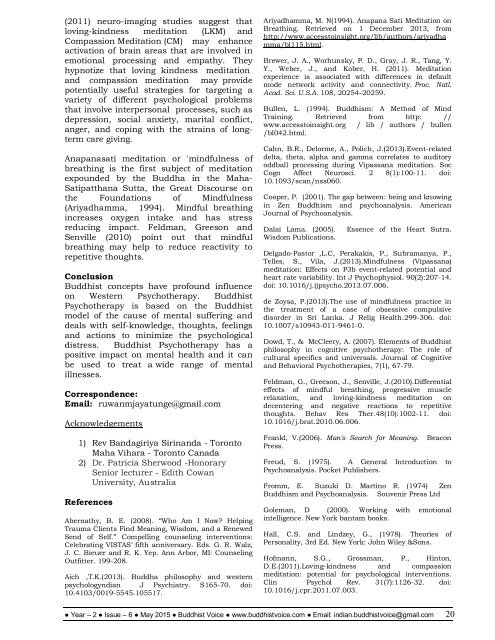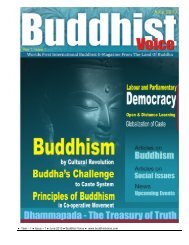BV - May 2015 Yr 2 Issue 6 E
You also want an ePaper? Increase the reach of your titles
YUMPU automatically turns print PDFs into web optimized ePapers that Google loves.
(2011) neuro-imaging studies suggest that<br />
loving-kindness meditation (LKM) and<br />
Compassion Meditation (CM) may enhance<br />
activation of brain areas that are involved in<br />
emotional processing and empathy. They<br />
hypnotize that loving kindness meditation<br />
and compassion meditation may provide<br />
potentially useful strategies for targeting a<br />
variety of different psychological problems<br />
that involve interpersonal processes, such as<br />
depression, social anxiety, marital conflict,<br />
anger, and coping with the strains of longterm<br />
care giving.<br />
Anapanasati meditation or 'mindfulness of<br />
breathing is the first subject of meditation<br />
expounded by the Buddha in the Maha-<br />
Satipatthana Sutta, the Great Discourse on<br />
the Foundations of Mindfulness<br />
(Ariyadhamma, 1994). Mindful breathing<br />
increases oxygen intake and has stress<br />
reducing impact. Feldman, Greeson and<br />
Senville (2010) point out that mindful<br />
breathing may help to reduce reactivity to<br />
repetitive thoughts.<br />
Conclusion<br />
Buddhist concepts have profound influence<br />
on Western Psychotherapy. Buddhist<br />
Psychotherapy is based on the Buddhist<br />
model of the cause of mental suffering and<br />
deals with self-knowledge, thoughts, feelings<br />
and actions to minimize the psychological<br />
distress. Buddhist Psychotherapy has a<br />
positive impact on mental health and it can<br />
be used to treat a wide range of mental<br />
illnesses.<br />
Correspondence:<br />
Email: ruwanmjayatunge@gmail.com<br />
Acknowledgements<br />
1) Rev Bandagiriya Sirinanda - Toronto<br />
Maha Vihara - Toronto Canada<br />
2) Dr. Patricia Sherwood -Honorary<br />
Senior lecturer - Edith Cowan<br />
University, Australia<br />
References<br />
Abernathy, B. E. (2008). “Who Am I Now? Helping<br />
Trauma Clients Find Meaning, Wisdom, and a Renewed<br />
Send of Self.” Compelling counseling interventions:<br />
Celebrating VISTAS’ fifth anniversary. Eds. G. R. Walz,<br />
J. C. Bieuer and R. K. Yep. Ann Arbor, MI: Counseling<br />
Outfitter. 199-208.<br />
Aich ,T.K.(2013). Buddha philosophy and western<br />
psychologyndian J Psychiatry. S165-70. doi:<br />
10.4103/0019-5545.105517.<br />
Ariyadhamma, M. N(1994). Anapana Sati Meditation on<br />
Breathing. Retrieved on 1 December 2013, from<br />
http://www.accesstoinsight.org/lib/authors/ariyadha<br />
mma/bl115.html.<br />
Brewer, J. A., Worhunsky, P. D., Gray, J. R., Tang, Y.<br />
Y., Weber, J., and Kober, H. (2011). Meditation<br />
experience is associated with differences in default<br />
mode network activity and connectivity. Proc. Natl.<br />
Acad. Sci. U.S.A. 108, 20254–20259.<br />
Bullen, L. (1994). Buddhism: A Method of Mind<br />
Training. Retrieved from http: //<br />
www.accesstoinsight.org / lib / authors / bullen<br />
/bl042.html.<br />
Cahn, B.R., Delorme, A., Polich, J.(2013).Event-related<br />
delta, theta, alpha and gamma correlates to auditory<br />
oddball processing during Vipassana meditation. Soc<br />
Cogn Affect Neurosci. 2 8(1):100-11. doi:<br />
10.1093/scan/nss060.<br />
Cooper, P. (2001). The gap between: being and knowing<br />
in Zen Buddhism and psychoanalysis. American<br />
Journal of Psychoanalysis.<br />
Dalai Lama. (2005).<br />
Wisdom Publications.<br />
Essence of the Heart Sutra.<br />
Delgado-Pastor ,L.C, Perakakis, P., Subramanya, P.,<br />
Telles, S., Vila, J.(2013).Mindfulness (Vipassana)<br />
meditation: Effects on P3b event-related potential and<br />
heart rate variability. Int J Psychophysiol. 90(2):207-14.<br />
doi: 10.1016/j.ijpsycho.2013.07.006.<br />
de Zoysa, P.(2013).The use of mindfulness practice in<br />
the treatment of a case of obsessive compulsive<br />
disorder in Sri Lanka. J Relig Health.299-306. doi:<br />
10.1007/s10943-011-9461-0.<br />
Dowd, T., & McCleery, A. (2007). Elements of Buddhist<br />
philosophy in cognitive psychotherapy: The role of<br />
cultural specifics and universals. Journal of Cognitive<br />
and Behavioral Psychotherapies, 7(1), 67-79.<br />
Feldman, G., Greeson, J., Senville, J.(2010).Differential<br />
effects of mindful breathing, progressive muscle<br />
relaxation, and loving-kindness meditation on<br />
decentering and negative reactions to repetitive<br />
thoughts. Behav Res Ther.48(10):1002-11. doi:<br />
10.1016/j.brat.2010.06.006.<br />
Frankl, V.(2006). Man's Search for Meaning.<br />
Press.<br />
Beacon<br />
Freud, S. (1975). A General Introduction to<br />
Psychoanalysis. Pocket Publishers.<br />
Fromm, E. Suzuki D. Martino R. (1974) Zen<br />
Buddhism and Psychoanalysis. Souvenir Press Ltd<br />
Goleman, D (2000). Working with emotional<br />
intelligence. New York bantam books.<br />
Hall, C.S. and Lindzey, G., (1978). Theories of<br />
Personality, 3rd Ed. New York: John Wiley &Sons.<br />
Hofmann, S.G., Grossman, P., Hinton,<br />
D.E.(2011).Loving-kindness and compassion<br />
meditation: potential for psychological interventions.<br />
Clin Psychol Rev. 31(7):1126-32. doi:<br />
10.1016/j.cpr.2011.07.003.<br />
● Year – 2 ● <strong>Issue</strong> – 6 ● <strong>May</strong> <strong>2015</strong> ● Buddhist Voice ● www.buddhistvoice.com ● Email: indian.buddhistvoice@gmail.com 20



